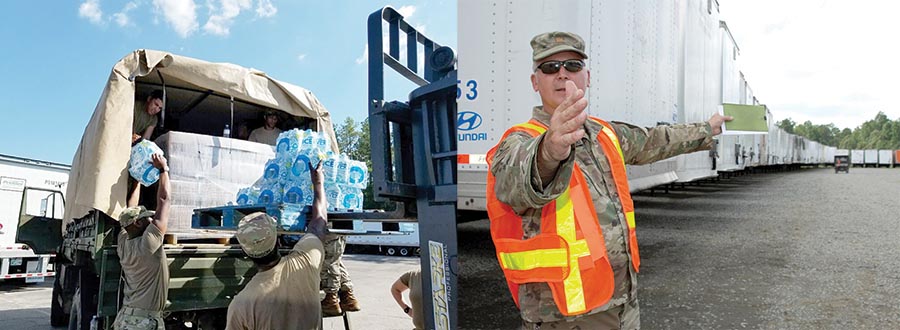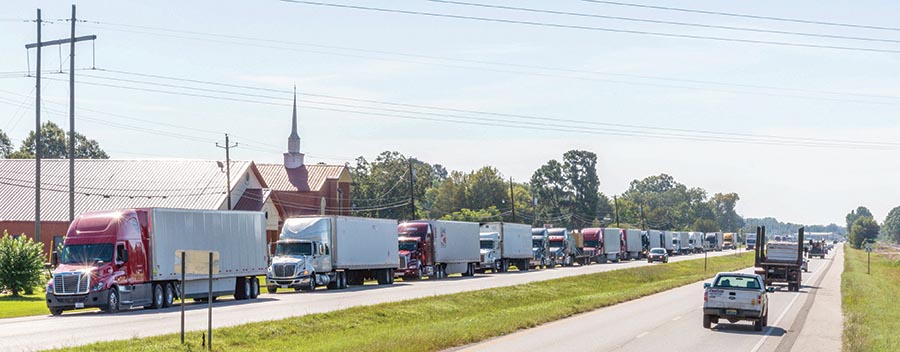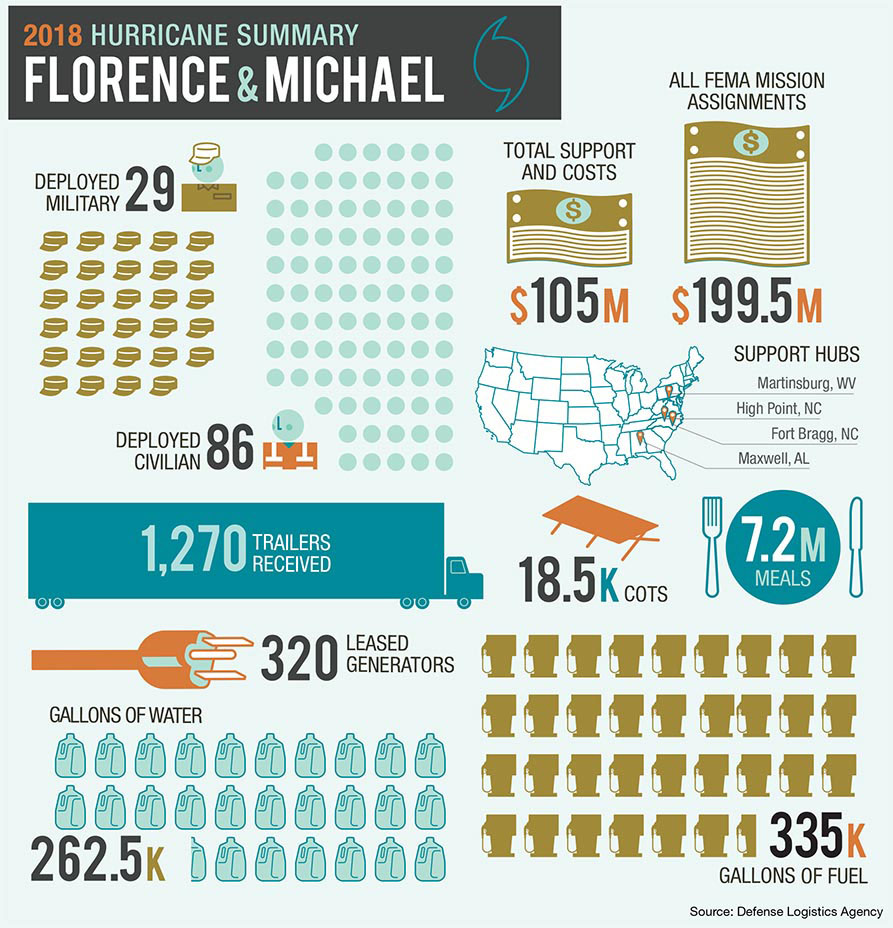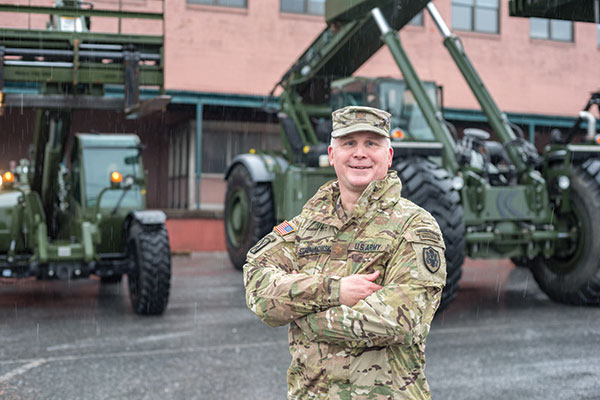System Report: How the Defense Logistics Agency does disaster relief
When natural disasters strike, the Defense Logistics Agency brings its distribution and logistics expertise to support relief efforts.
Anyone watching the weather reports in late August 2018 knew that Hurricane Florence was going to be a big deal. The storm is now recognized as the wettest tropical storm to ever hit the Carolinas and one of the wettest to ever impact the United States. It began forming off the coast of Africa on August 30. By September 4, it was a Category 4 storm and by September 10, it was barreling toward the North Carolina coast with estimated maximum sustained winds of 130 miles per hour.
Governors up and down the Atlantic coast began issuing evacuation orders. By the time Florence made landfall as a Category 1 storm near Wrightsville Beach, N.C., on September 14, the Defense Logistics Agency was ready with a rapidly deployable distribution center at Fort A.P. Hill in Virginia to receive and stage disaster relief supplies for delivery into the field. The mobile distribution center, known as DLA Distribution Expeditionary, or DDXX, also provided supplies and support to FEMA at Fort Bragg in North Carolina, and Maxwell Air Force Base in Alabama. Given the frequency of these major storms, DLA is becoming the logistics provider of choice for FEMA. Its deployable distribution centers are routinely called upon to serve as FEMA’s Incident Support Bases, or ISBs, where huge quantities of relief supplies and other commodities are staged before they are called forward to the impacted area.
Relief efforts for Florence and Michael, and all of the natural disasters involving the DLA in the fall of 2018, were supported by U.S. Army Major Edward Strzalkowski, or Major Ski, who is the commander of DLA DDXX. Based at the DLA Distribution Headquarters in New Cumberland, Pa., Strzalkowski took over the command in July 2018.
DLA Distribution Expeditionary at a glance
When it comes to disaster relief, the DLA Distribution Expeditionary Force is designed to support disasters inside and outside the continental United States:
- Assessment team deploys within 24 hours.
- Main body deploys within 48 hours.
- Life support package sustains for 7 days.
- 100 plus civilian personnel.
- Materials handling equipment.
- Deployable communications package.
- Provides 24-hour Incident Support Base (ISB) support.
- Processes material to support 200,000 people per day with meals, water, ice, tarps and other relief essentials.
Source: Defense Logistics Agency
“We are a scalable asset that can deploy on a moment’s notice,” Strzalkowski says. “We support everything from the deployed warfighter to FEMA and have the capability to stock, store and distribute relief supplies that are needed, ranging from water to fuel to generators. It’s a flexible solution that fits all scenarios.”
While they’re called distribution centers, DDXX’s are a distribution center in the loosest sense of the word. Forget pallet rack, conveyor or even four walls and a roof. For the most part, storage consists of trailer- and container-loads of material checked into a warehouse management system (WMS) and ready to be sent where needed and when needed. Simple, yes, but it’s also effective.
Over the course of Florence, the DLA processed 1,159 trailers full of relief supplies using 11 military personnel and 37 civilians who are part of the DDXX team. A month later, the DLA was pressed back into action when Hurricane Michael blasted the Florida Panhandle. In the following pages, we’ll look at how DLA has expanded its role from supporting combat troops on the battlefield to providing distribution and logistical support to civilian agencies when natural disaster strikes.

Disaster relief logistics are built for speed: Product is received by the truckload (left); unloaded quickly; and then reloaded into outbound trailers for delivery (right).
New needs, new capabilities
The old line that an army marches on its stomach underscores the importance of logistics to a military organization. After all, you can’t fight a battle if your soldiers aren’t fed and armed. The Defense Logistics Agency does that from multiple distribution centers from around the world, comprising nine supply chains, some 3,200 procurement professionals and 1.5 million line items. “We have a reputation for delivering the right item at the right time at the right price,” says Dan Strausbaugh, DLA’s liaison officer to FEMA.
For years, the DLA’s supply chain resembled that of any major retailer or manufacturer. Product was purchased from suppliers and shipped to DLA distribution centers for redistribution to other DCs and ultimately to a theater of operation, often by air lift. “That worked for warfighting then because of its large scale, with a lot of buildup and planning,” says Patrick Mackin, a DLA spokesperson. “But in the last 20 years, the entire military has become more expeditionary, which requires quick reaction.”
In 2010, the DDXX was developed to support contingency operations to Kandahar, Afghanistan. The idea was to create an agile, flexible distribution option to improve the distribution of material in the early days of a conflict—everything from meals to spare parts to fuel to specialized equipment like rough terrain forklifts—while minimizing the reliance on strategic airlifts. DDXX uses a dedicated team of highly skilled civilians from the three DLA DCs in Susquehanna, Pa., Red River, Texas, and San Joaquin, Calif., who are on standby status while working at the DCs or training. They can be in place where they’re needed within hours.
To shorten the supply chain, supplies may go directly from a primary warehouse, often near the action, or directly from a supplier to the ISBs, where the team receives and stages the material and then rapidly pushes it out into the field as needed. Once the distribution is done, the local operations are quickly dismantled and removed from the field. For disaster response in the continental United States, DLA’s support normally falls under the United States Northern Command, or USNORTHCOM, located in Colorado Springs, which directs all the military units involved in the national response effort.
Strzalkowski describes it as “a tangible example of how the DLA and U.S. military logistics have moved from a static, industrial base posture for warehousing and distribution of commodities to a rapid deployment mentality.” For instance, the DLA has contracts with providers of items like meals ready to eat, or MREs, that can deliver millions of meals into the field on short notice.
While the capability was developed to support operations in a war zone, the similarities with disaster relief are striking: These are big events that potentially affect millions of people and require a response in a matter of hours or days, not weeks and months. The “wake-up call” was 2012’s Hurricane Sandy. “DLA played a bigger role in that relief effort than we had in past disasters,” says Mackin. “Other agencies saw the value we could bring because of the way we do things and the connections we have with the industrial base. And, our leadership said going forward, this is going to be the norm rather than the exception.”
Planning for relief
Disaster relief logistics at the DLA is a two-step process. The first step is planning, which happens on an ongoing basis. “We continually exercise our different capabilities to make sure we can meet the demands of FEMA,” says Strausbaugh, who is embedded with FEMA at all times. “We create pre-scripted mission assignments, which are statements of work of the responsibilities and commodities that we can respond with through our distribution centers or contracts with vendors.” As an example, in a disaster, you need 3 liters of water a day per person, or 3 million liters of water a day for a disaster that will impact 1 million people.
As the link between DLA headquarters, FEMA and other agencies, Strausbaugh jokes that his primary role is “to do a lot of talking.” When a federal emergency is declared, he is typically given 2 hours to get to the National Response Coordination Center in Washington, where FEMA and other agencies gather to marshal their forces. In the field, FEMA operates its own incident support bases, where the agency collects inbound support materials near impacted areas. When FEMA doesn’t have enough resources of its own or the personnel to provide logistical support, it calls on the DLA to augment relief supplies or to operate a support base to receive, stage and distribute supplies.
When that happens, Strausbaugh’s job is to create a mission assignment for the support that DLA can provide and pass that to a Joint Logistics Operation Center (JLOC) at DLA headquarters, which is the communications hub for DLA. The JLOC, in turn, passes the mission assignment to the commodity supply chains. In turn, they then arrange the procurement and shipment of the needed supplies and the movement of equipment and personnel. Those could go to a FEMA ISB or to a DLA ISB. The mission statement also authorizes funding through the Disaster Relief Fund to reimburse that support.
Hurricane Michael, the October 2018 storm that devastated the Florida Panhandle, was a case in point. “There was very little notice with Michael,” recalls Strausbaugh. “On Friday, everyone left work, and it was no big deal. On Sunday, I got a call that FEMA was going to need help.” Strausbaugh monitored the storm from home over the Columbus Day weekend. On Tuesday, October 9, FEMA activated the response center.
“Over the weekend, I began making plans for power generation because we knew it was going into the Panhandle,” he says. “We also worked on a plan to support the state with fuel because if the area lost power, the commercial gas stations would go down.”
On Tuesday, there were some 300 people from various federal agencies at the NRCC. Although Strausbaugh has to wait until FEMA exhausts its resources before DLA formally becomes involved, he began making preliminary calls. “We knew we could potentially need millions of meals in the next few days, so the individual with the rationing supply chain went out to his meal vendors to find out how many they could commit to. Because we have pre-scripted missions and contracts, we don’t need long lead times.” There was also planning to take a “metered approach” to moving supplies into the area—in this case to an ISB at Maxwell Air Force Base, where FEMA had already set up shop and staged water and meals because of Florence.

A convoy of trucks are on the road to deliver relief supplies to the affected areas.
“We don’t want to clog up the different service transportation lanes with too many tractor trailers going in,” Strausbaugh says. “So, in this case, we waited until the area was cleared of hazards and until FEMA started moving its staged materials to survivors, freeing up storage space at Maxwell.”
The process, Strausbaugh says, is much like Dell’s just-in-time supply chain, where parts and components for computers it expects to make are at the ready, kitted together in advance of a need. “Then, when we get the order, we’re ready to go,” he says.
Distribution on the fly
Execution of the plan developed by the DLA liaison officer is the second step. That falls to Major Ski and the DDXX. “We’re basically a depot in a box,” Strzalkowski says. “We have equipment we can deploy in a rapid means, whether that’s by truck, ship or air transport. With that capability, we create a consolidation shipping point, which can be anywhere. Ideally, it’s some kind of pavement, and if we can get a building that’s better. But if we have a place that’s somewhat flat, we can set up.”
In a typical mission, like support for FEMA during Hurricane Florence, DDXX will set up operations in a 5,000 or so square foot area. The popup distribution centers usually include two expandable 20-foot trailers that serve as a mobile command center. One is large enough to have a classroom and the other has four workstations. DDXX has its own generators, lights, communications equipment and even utility trucks for refueling. Since these are temporary operations, the team brings its own tents for sleeping quarters.
Storage at an ISB resembles yard management more than it does warehouse management. Instead of pallet rack inside four walls, product is received and stored in the yard at the ISB in shipping containers or trailers. For handling and conveyance, operations rely on rough terrain containerized handling vehicles to off-load, stage and load containers; yard dogs to move trailers; and lift trucks that can load and unload containers and trailers if needed.
Inventory is tracked by a FEMA system that provides visibility from the time it’s processed until it reaches the ISB. High-value items and some commodities are tracked by GPS transponders. “We can set up interrogators to track the location of those items,” Strzalkowski says.
When it comes to actually executing the mission and deploying the DDXX, Strzalkowski gets an advance notification that he may be called into action. With Hurricane Florence, that came through on Thursday, September 6, about a week before the hurricane made landfall. The next day, a state of emergency was declared.
The DDXX team met that afternoon and began packing equipment. Meanwhile, personnel at the San Joaquin distribution center also began getting ready to deploy. On Sunday, September 8, an advance DDXX team went to Fort AP Hill in Virginia. There, they linked up with regional FEMA representatives to discuss what’s coming in.
“At AP Hill, there was an energy mission, so we had generators and fuel trucks with propane, diesel and unleaded gasoline,” Strzalkowski says. The mission also included receiving and staging some 200 containers in a 24-hour period with food, water, cots, diapers, tarps, blankets and consumable medical supplies.
Disaster relief by the numbers
Natural disasters are costly, by any measure. To support the victims in Florida and the Carolinas after hurricanes Florence and Michael during the 2018 hurricane season, here’s what DLA offered:

This represents support above and beyond what was provided by FEMA and the American Red Cross. As Dan Strausbaugh, the DLA liaison officer to FEMA puts it, “the DLA has become a heavy lift in support of civilian authorities. They come to us because there’s no hesitation, and there’s a quick response.”
That afternoon, the advance team worked on a plan to receive and organize inbound trailers. “We knew there were going to be a lot of trucks coming through the gates, and there were concerns about tying up Route 301, so we met with local community personnel and their staff,” Strzalkowski says.
By Monday, September 9, roughly three days before the hurricane made landfall, the mobile emergency response center was up and running. During this time, FEMA was also setting up ISBs at Fort Bragg and Maxwell Air Force Base. These were managed by FEMA personnel but received commodities from the DLA.
At that point, Strzalkowski says, DDXX waited for orders to begin shipping trailers out. “When that happens, we go to a 24-hour shipping process,” he says. “FEMA asks us to send commodity trailers to certain locations. We hook them up and ship them out.” Sometimes, it’s circular—a trucker drops off a trailer of a commodity at an ISB and then hooks up with a needed trailer to make a delivery.
DDXX learns to expect the unexpected. During Florence, FEMA requested an unexpected 50 trailers in one day. One morning, Strzalkowski looked out to see 100 ambulances from around the country showing up at the gate because they didn’t have any place else to go.
A week later, it was over. While the flooding continued for some time, the damage was not as great as expected, and DDXX was no longer needed at the AP Hill ISB. “We spent about 24 hours training FEMA reserves in our operations and procedures and then we were completely out of there.” In total, DDXX processed 1,159 trailers in a short period of time, using 11 military personnel and 27 civilians. Then, they waited to get pressed into service again. “This is really a team effort, from DLA headquarters to our distribution headquarters,” Strzalkowski says. “Our team members are all volunteers who are going to be fit and ready to be part of the mission when we’re deployed.”

Article Topics
Storage News & Resources
Walmart chooses Swisslog AS/RS and software for third milk processing facility Steele Solutions showcases advanced structural steel platforms and materials handling chutes HWArobotics delivers advanced AS/RS technology to e-commerce specialist Darwynn Frazier shows Pallet Spacing System and Method Steel King Industries announces strategic collaboration with Automha Americas Kardex FulfillX for AutoStore can help businesses meet goals in under 6 months The Stow Group puts the spotlight on its Movu Robotics brand More StorageLatest in Materials Handling
The (Not So) Secret Weapons: How Key Cabinets and Asset Management Lockers Are Changing Supply Chain Operations MODEX C-Suite Interview with Harold Vanasse: The perfect blend of automation and sustainability Consultant and industry leader John M. Hill passes on at age 86 Registration open for Pack Expo International 2024 Walmart chooses Swisslog AS/RS and software for third milk processing facility NetLogistik partners with Vuzix subsidiary Moviynt to offer mobility solutions for warehouses Materials Handling Robotics: The new world of heterogeneous robotic integration More Materials HandlingAbout the Author
Subscribe to Materials Handling Magazine

Find out what the world's most innovative companies are doing to improve productivity in their plants and distribution centers.
Start your FREE subscription today.
April 2024 Modern Materials Handling

Latest Resources












